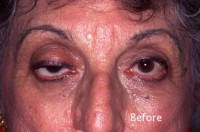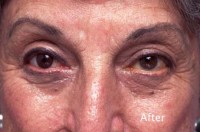Lacrimal Surgery Beverly Hills
LACRIMAL OR TEAR DUCT SURGERY
The lacrimal system is comprised of the lacrimal gland that produces tears, and a drain system that starts in the inner corner of the eyelids. There are small openings called puncta that drain into small lined tubes in the eyelid call the canaliculus. On each eyelid there is a canaliculus in the upper eyelid and lower eyelid. These drain into the nasolacrimal duct,which ultimately drains into the nose. Drainage problems in this system typically cause excess tearing. Depending on the precise location of the blockage, there can also be mucus discharge and/or crusting of the eyelashes.
A blocked tear sac can actually be the source of acute and chronic infections. By far, the most common symptom of a dysfunctional lacrimal system is excessive tearing, causing tears to run down the cheek for no apparent reason. Friends and family watching you dab your face with a tissue many not appreciate how annoying and embarrassing this problem can be. Excessive tearing can also obscure one’s vision and hinder one’s ability to perform necessary work duties. Although it is rare for the obstructed tear system to lead to infection, when this does arise, surgery on the tear sac to bypass the obstruction is the appropriate treatment. Excess tearing may persist for quite some time before individuals get sufficiently motivated to have surgery to address this concern.
Tear duct obstruction in adults does not respond to massage, flushing of the ducts, antibiotics, eye drops or office probing, and often requires surgical intervention. In order to ensure a safe and effective lacrimal surgery, it is crucially important to select an experienced oculofacial surgeon who possesses the necessary skillset and in-depth knowledge of the intricate eye structures. You will find such a physician in Dr. Kenneth Steinsapir, a multi-fellowship-trained oculofacial plastic surgeon whose private practice is located in beautiful Beverly Hills, CA, where he specializes in personalized reconstructive eyelid surgery procedures and has a proven track record of producing successful lacrimal surgery outcomes.
INFANT LACRIMAL DUCT OBSTRUCTION
Congenital lasolacrimal duct obstruction (NLDO) is very common in infants, and approximately 95% of infant tear duct obstructions resolve on their own, before the child’s first birthday. Antibiotics and massaging the blocked tear duct can help the duct to open; however, if these measures fail to improve the situation, surgical probing of the tear ducts by 12 months of age is generally recommended.
When performing surgical probing of the tear ducts on an infant, Dr. Steinsapir has found that brief general anesthesia minimizes any traumatization and permits optimal probing with a higher likelihood of success. Although surgical probing successfully opens the blocked duct for most babies, should tearing persist, the placement of tubes and additional procedures may be needed.
ADULT TEAR DUCT OBSTRUCTION
In adults, probing of a blocked tear duct is unlikely to improve the tearing. During the initial consultation with an adult patient, Dr. Steinsapir will perform a diagnostic irrigation of the tear duct system to attain a clearer picture of the anatomic blockage, so that he can make a more accurate recommendation as to the appropriate treatment course. For many adults with excessive tearing, a dacryocystorhinostomy (DCR) is the optimal corrective surgery. During this procedure, Dr. Steinsapir will create an opening in the bone between the blocked tear sac and the nose. He will then attach the lining of the tear sac to the lining of the nose to form a permanent drainage channel for the patient’s tears.
In most cases, a clear plastic tube will be placed temporarily to help stent the tear drainage system and prevent scarring (this tube will be removed 6 months later). DCR surgery can be performed on an outpatient basis under IV sedation, and sutures are removed at 1 week. It is common to take 7 to 14 days off from work. This will vary depending on the nature of your work. There is a small scar along the side of the nose but often this heals very well over the course of a few weeks to months. A personal consultation with Dr. Steinsapir will determine if the DCR procedure is the optimal approach to address your malfunctioning tear duct(s).
CONTACT DR. STEINSAPIR
Dr. Steinsapir is a UCLA- and University of Chicago-trained surgeon who has performed separate fellowships in both Cosmetic Surgery and Oculofacial Microsurgery. Many individuals travel nationally and internationally to undergo reconstructive eyelid surgery and other facial rejuvenation procedures with Dr. Steinsapir. To learn how lacrimal surgery can restore proper functionality to your tear ducts (or the tear ducts of your child), please don’t hesitate to contact our office.
You may also continue to explore Dr. Steinsapir’s website (www.Lidlift.com), where you will find supplementary information pertaining to lacrimal surgery and other reconstructive eyelid procedures, before-and-after eyelid surgery case studies, and answers to frequently asked questions about these procedures. Your lacrimal surgery can serve as a key stepping stone along the path to become the best possible version of yourself, and you can take the first step by calling to schedule your personal consultation with Dr. Steinsapir today.


